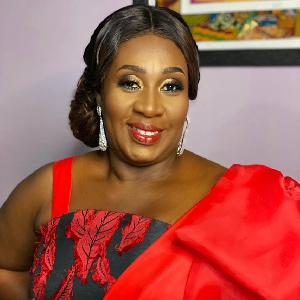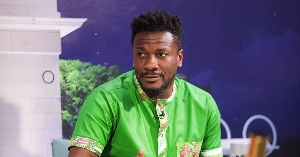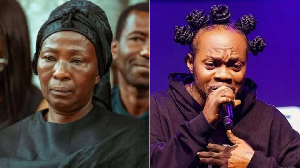(Part 1)!
What is the problem again? The concrete urethra of the Supreme Court, otherwise called “Okyeman Supreme Court of the Gold Coast,” is choked with loads of unattended dossiers and dockets of cases from A to Z and 1 to 9. The year is 2014 JBD, JDB short for Joseph Boakye Danquah, a pre-historic humanized phantom with a starched ballooned sense of atomized intellectual globality, a chameleonic anti-people man of the people, Chinua Achebe’s “Man of the People” of sorts. On the other hand, Busia, Danquah’s other strange half, a shy but in-your-face talking drum, an outwardly-directed self-talking fontofrom, is a topological semi-circle of political Machiavellism!
Taken together, the two constitute brimstone of political and social acidity in the vaginal aperture of Ghanaian politics. Thus, Danquah represents both the earth and the sun, both Jesus Christ and Prophet Muhammad, both alpha and omega, both geocentrism and heliocentrism, and both life and death of pre-historic and post-historic Gold Coast politics. Before him there is none, after him there will be none! In other words, the political bi-curious Danquah is a full circle of cranial none-ness. Arguably, he is the circle of political mensuration and the dot of philosophical coordinate-geometry. What a political circle and philosophical dot of relative completeness, of relative roundedness!
September 13, 2014 JBD. The Presiding Judge, Siamese Twins, is represented by Nana Ofori Atta 1 and Nana Ofori Atta 11, who, are, in turn, represented by the Fanti-turned Akyem, Dr. Kwegyir Aggrey. Okyeame Kodwo Aggrey, Aggrey’s father, now late, came from a powerful Fanti clan. This clan, now as before, produces a hereditary lineage for the covetous office of the Okyeame in the Fantiland of Anomabo, more so because this prestigious office of the Okyeame is not for non-Fantis, “outsiders.”
In fact, Okyeame Kodwo Aggrey was the most powerful elder in the Council of Amonu 1V, the Great King of Anomabo. Even when Kwegyir Aggrey had returned from North Carolina, USA, a large piece of land separated from the Gold Coast by an ocean of water and salt and weird animals of strange sizes, shapes, and colors, and before he had teamed up with Sir Gordon Guggisberg to found Achimota College, he had briefly assumed the Okyeameship in the great Fantiland of Anomabo, a social responsibility carried out strictly in line with the stipulations of tradition and culture! Everyone, even unborn fetuses, knows he is indubitably a Fanti, not Akyem.
Whence cometh this urban myth! Therefore, Dr. Kwegyir Aggrey is emphatically out-and-out Fanti—through and through. Today, he is representing Osagyefo Dr. Kwame Nkrumah as his defense attorney. Quite captivatingly, it is a proverbial fixture of public imagination that the average Ghanaian citizen, formally educated and informally educated, will rush like an avalanche of human snow, merely to have a great man of outstanding legal and jurisprudential prowess, such as he, the unrivaled Dr. Kwegyir Aggrey, a brilliant scholar who speaks with rhetorical flair typical of the outspoken, learned, and sagacious Prof. Parrot, Dr. Kofi Awoonor himself. Yes, every Ghanaian wants to betroth his or her retainer to the marriageable professional lapel of Dr. Kwegyir Aggrey, a legal clairvoyant who is able to give surgically correct verdicts even before the wobbling feet of difficult, controversial cases go before the judicatory pillow of the courts.
Before long, the court clerk, Nana Agyeman Konadu-Rawlings, administers separate oaths to Danquah and Nkrumah. Initially, Danquah resists taking the sacred oath by citing a regime of Frankenstein religious beliefs centering on Danquah-esque Pan-Eurocentric Atheism, whatever that is. Others in the courtroom, however, think otherwise. That notwithstanding, the question courtroom spectators and the general public want to hear is, what are Osagyefo Dr. Kwame Nkrumah’s crimes? Well, all the crimes of humanity committed by Nkrumah revolve around his alleged personification of Danquah, the ideological circumference of Ghanaian politics. The charges are as follows:
1) JB Danquah built the Akosombo Dam
2) JB Danquah acquired lands on behalf of the people of Ghana and raised the University of Ghana, the University of Cape Coast, and Kwame Nkrumah University of Science and Technology on them
3) JB Danquah built the Tetteh Quarshie Memorial Hospital
4) JB Danquah founded the Ghana Academy of Arts and Sciences
5) JB Danquah built the Tarkwa Oil Refinery and the Tema Oil Refinery
6) JB Danquah built most of the educational institutions in Ghana
7) JB Danquah married Fathia Nkrumah and together they produced Dr. Francis Nkrumah, Samia Nkrumah, Dr. Gamal Nkrumah, and Dr. Sekou Nkrumah
8) JB Danquah declared the Gold Coast independent on the 6th of March, 1957, in the company of Obetsebi Lamptey, Idi Amin, Linguist Baffour Akoto, KA Busia, Akwasi Afrifa, Mobuto Sese Seko, and Apartheid, all on the Old Polo Grounds.
9) JB Danquah formed the Ghana Football League Association
10) JB Danquah is Kwame Nkrumah. The gold statue of Kwame Nkrumah stationed before the headquarters of the African Union (AU) is JB Danquah; the Kwame Nkrumah Mausoleum is JB Danquah Mausoleum; Kwame Nkrumah Chair (Institute of African Studies), University of Ghana, is JB Danquah Chair (Institute of African Studies), University of Ghana; Kwame Nkrumah Memorial Lectures, University of Cape Coast, is JB Danquah Memorial Lectures, University of Cape Coast; and, finally, the Biennial Kwame Nkrumah International Conference (KNIC, Canada) is the Biennial JB Danquah Akyem Conference (JBDIC, Akyem)
These laughably, frivolously serious package of charges turns the courtroom into a pandemonium of speechifying ablaze, with flying gesticulations taking the place of courtly vacuum and mouthy contortions aerosolizing the courtly ambience with bubbling atoms of sweltering saliva, scattering higgledy-piggledy in the narrowing claustrophobia of the charged courtroom. It is really a heavy downpour of saliva. Even so, there are also inexplicable suspensions of dancing human figures in empty spaces lodged between the bench and courtly spectators, as well as are wiggly silhouettes on courtly walls, both inside the courtroom. “Order in court! Order in court! Order in court!” cried the mouthy gavel of the Judge. The Judge’s feigned piecing baritone tears through the thick blanket of uproar as a hot knife waltzes through a heavy block of butter unimpeded—with ease.
In no time, the errand god of blanket silence soon makes a bold presence in the courtroom, apparently from the psycho-emotional wellspring of spectatorial humanness. But court spectators sense a phenomenon of rhetorical untowardness in the demeanor of the sitting Judge. And it has to do with oratorical doubleness. More specifically, there is a vocal overlap between a baritone and a tenor, an oratorical dualism of sorts, seemingly trapped in a unitary body of judicatory solemnity behind the bench. Accordingly, it turns out Nana Ofori Atta 1 is KA Busia and Nana Ofori Atta 11 JB Danquah. The question is, how does anyone fully explain this strange phenomenon, this anatomical blending as well as vocal conflation? Unsurprisingly, Dr. Kwegyir Aggrey sees through the thicket of anatomic, behavioral, and vocal shenanigans and says nothing! Often, he uses pen and silence as strategic weapons to unravel the vastness of his intellect. Today is one of those days of intellectual revival, of revelation, of truth!
The case proceeds in earnest. The first charge the court takes up is the issue of whether Danquah has any legitimate or moral claim to the University College of the Gold Coast, now the University of Ghana, a question to which Dr. Kwegyir Aggrey emphatically said “No.” Then, Dr. Kwegyir Aggrey immediately invokes a precedent, Cocobod v. Dr. Kwame Botwe-Asamoah, 1950. This contentious case had involved Dr. Kwame Botwe-Asamoah, a legal historian, boldly challenging JB Danquah, a paralegal professor, on the question of the founding of the University College of the Gold Coast, the long trajectory of history behind the latter University, and how the state generated the required funds to construct this University and other national infrastructure.
It should be recalled that these questions have nothing to do with the 1947 formation of the Ghana Cocoa Board (Cocobod) and the construction of the University College of the Gold Coast. Remember, again, the year 1947! Again, the court is not interested in whether JB Danquah had founded or co-founded Cocobod. The central issue before the court today is determining how the state generated funds to construct the three tertiary institutions and other infrastructure of national importance. These are questions Nkrumah’s lawyer is ready to answer with great intellectual and analytic finesse. Nonetheless, before Dr. Kwegyir Aggrey delves into any precedential analysis, he invokes another historical precedent courtesy of Dr. Kwame Botwe-Asamoah. He reads to the court:
“In 1911, Casely-Hayford took up Dr. Africanus Horton’s proposals for a West African University, and rather campaigned for a university for the Gold Coast. Nine years later, the National Congress of British West Africa, led by Casely-Hayford, petitioned the British Government ‘to found a British West African University on such lines as would preserve in the students a sense of African nationality,” writes Kwame Botwe-Asamoah, he says, adding: “This request yielded no positive response until 1945, when the Colonial Government finally embraced the idea of a university for the Gold Coast. This change of attitude was based on two separate reports submitted to the Colonial Government by Asquith and Elliot Commissions. Contained in the reports, the mission of the university was to train a new platonic African elite (See “Kwame Nkrumah’s Politico-Cultural Thought and Politics,” p. 150; see also Geoffrey Bing’s “Reap the Whirlwind,” p. 348-349).”
Dr. Kwegyir Aggrey, however, takes a fleeting break and continues to read to the court, quoting the written authority of Nana Ofori Atta Ayim in addition to punctuating it with a series of verbal annotations here and there: “Dr. Danquah was a protégé of the celebrated and iconic God-father of West African nationalism and the pioneer Pan-Africanist, Joseph Ephraim Casely-Hayford. In his own words, it was at the feet of the eminent nationalist, ‘Ekra Agyemang,’ otherwise known as Joseph Ephraim Casely-Hayford, that I was brought up, like St Paul under Gamaliel, and it was from Ekra Agyeman that I learned selfless politics as the sacrificing of one’s self totality for one’s own country. I sat under his feet from 1915 to his own death in 1930.” The court goes uncomfortably, silently haywire as he reads and further explains this portion of his legal arguments.
Dr. Kwegyir Aggrey continues: “The call by the Okyehene to rename the premier university of Ghana after Dr. J.B. Danquah is the most absurd of the public statements. In 1951, it was Danquah who vehemently and steadfastly opposed the 1951 Local Council Ordinance Bill and the establishment of Cocoa Marketing Board introduced by Nkrumah’s internal self-government.” Finally, he cites Dr. Kwame Botwe-Asamoah again in conclusion: “Thus, if Danquah had won the debate, the Kwame Nkrumah government would not have generated the requisite revenue for the first Five-Year Development Plan, containing the construction of the Volta River Project, Tema Harbor and City, Adomi Bridge, Okomfo Anokye Hospital, democratization of education, the Medical School and the planning and construction of the University of Ghana at Legon (See “Naming the University of Ghana after Danquah” under “The Fallacies of JB Danquah’s Heroic Legacy: Introduction”).”
We shall return…
Opinions of Thursday, 1 May 2014
Columnist: Kwarteng, Francis














